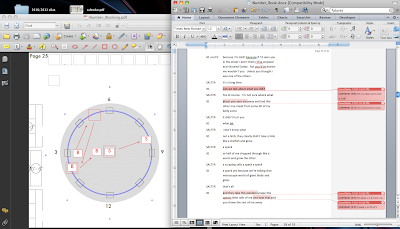- Reports, blocking, and line notes are much easier- Because I can update my documents at the source, I cut out the step of having to transfer the information that I've written down, risking forgetting small details that came up at the time.
- Finding information is quicker- any questions that arise during rehearsal can be easily solved by shooting out an email, searching for information online, or checking documents on the production website.
- People distrust that you are paying attention- Although the work that is being done on my computer is the same that would be done on a printed script in a binder, people in the room are less willing to believe that what I am looking at on the computer screen is a copy of my blocking script and that I am not simply surfing the internet.
- Distractions are more difficult to ignore- Because I am working from my personal computer, I find that I am often distracted by reminders of other tasks that do not involve Still Life. Every so often I have to work harder to remain focused than I normally would if I were working off of a computer that wasn't my own or out of a binder.
Overall, I think it has been a smooth rehearsal process as far as the switch to paperless is concerned. I feel that it will prove more beneficial as we move into tech and performances, but we will see!



